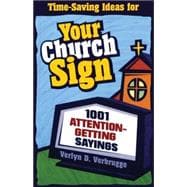
Note: Supplemental materials are not guaranteed with Rental or Used book purchases.
Purchase Benefits
What is included with this book?
| Contents | |
| Preface | |
| PART ONE: The Concept of the Church Sign | |
| 1. The Purpose of the Church Sign | |
| 2. The Caption | |
| PART TWO: Captions for the Church Sign | |
| Introduction | |
| Seasonal Captions | |
| Adaptations of Proverbs, Slogans, Sayings, and Songs | |
| Captions on Marriage and the Family | |
| Captions Related to Prayer | |
| Captions of Encouragement | |
| Captions of Going to Church | |
| Evangelistic Captions | |
| Captions of God in Charge | |
| Captions on the Bible | |
| Captions on Living a Christian Life | |
| Unclassified Christian Captions | |
| General Captions Relating to Proper Human Activity | |
| General Captions Relating to Proper Human Attitudes | |
| General Captions Relating to Proper Human Speech | |
| Other General Captions |
The New copy of this book will include any supplemental materials advertised. Please check the title of the book to determine if it should include any access cards, study guides, lab manuals, CDs, etc.
The Used, Rental and eBook copies of this book are not guaranteed to include any supplemental materials. Typically, only the book itself is included. This is true even if the title states it includes any access cards, study guides, lab manuals, CDs, etc.
Excerpted from Your Church Sign: 1001 Attention-Getting Sayings by Verlyn D. Verbrugge
All rights reserved by the original copyright owners. Excerpts are provided for display purposes only and may not be reproduced, reprinted or distributed without the written permission of the publisher.